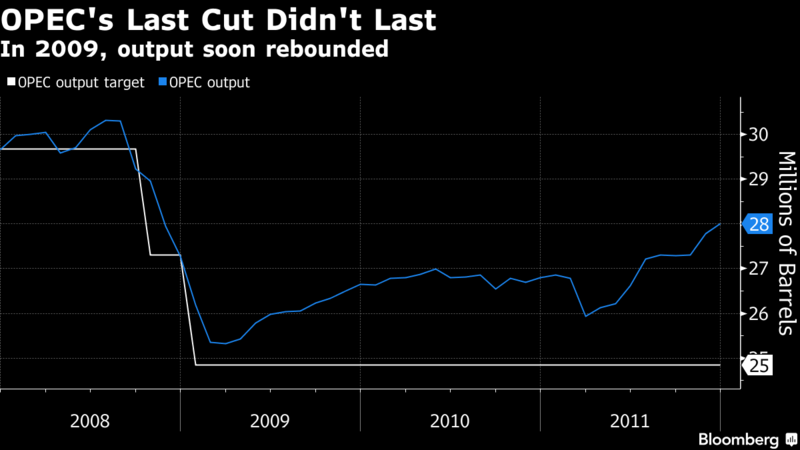OPEC Risks Deal Fatigue as Maintaining Oil Curbs Get Tougher
OPEC impressed oil traders this year by making almost all the supply cuts it promised. Keeping output down will only get harder.
The Organization of Petroleum Exporting Countries and its partners are expected to extend output curbs into early 2018 when they meet next week, in an ongoing bid to clear a global surplus. Yet the tailwinds that made cutting supply easier in the first half of the year — from a seasonal lull in demand to temporary oil-field maintenance — will be gone just as new obstacles are emerging.

To keep a lid on output this summer, Saudi Arabia will need to sacrifice an even bigger share of exports as consumption at home rises. Iraq yearns to expand capacity, and has already used the option of maintenance to keep oil fields idle. Meanwhile Nigeria and Libya, two OPEC nations exempt from the deal, are restoring lost output.
“They’re going to struggle,” said Michael Barry, director of research at consultants FGE in London. “This deal has been remarkable in its implementation. As time goes on, discipline is likely to erode. Almost every country wants their production to go up.”
Brent crude, the global benchmark, was trading 0.7 percent higher at $52.01 a barrel as of 12:46 p.m. in London.
As the world’s fuel-storage tanks remain brimming and prices languish, OPEC and its allies have conceded that the initial plan for six months of production cuts wasn’t long enough. Yet Saudi Arabia and Russia’s proposal that their 24-nation coalition, due to meet in Vienna on May 25, should extend the measures for another nine months may prove an unbearable strain.
“Production curbs for the first quarter of 2017 were comparatively easy to agree to,” said David Fyfe, chief economist at Geneva-based oil trader Gunvor Group. “They’ll likely agree to extend” but “the risk is higher they’ll leak extra barrels onto the market.”
OPEC showed an unprecedented level of commitment to this deal, implementing 96 percent of the cuts it promised during the first four months of the year, according to the International Energy Agency.
Holding Line
Some are optimistic that OPEC and its partners will maintain their resolve. The stakes are high enough that the organization will stick to its commitments, and as inventories decline producers will feel encouraged to stay the course, said Mike Wittner, head of oil market research at Societe Generale SA in New York.
“They’re going to hold the line,” said Wittner. “If we see stock draws happening soon, which we believe will be the case, those signs of success will bolster their determination. When you see light at the end of the tunnel, it’s easier to keep it together.”
Still, strong compliance was often attributable to Saudi Arabia cutting more than it was required, compensating for laggards like Iraq and the United Arab Emirates.
If the kingdom continues to restrain output, it needs to make another sacrifice. The Saudis typically boost production during the summer to maintain exports while meeting increased local demand from air conditioning. Keeping a cap on output would mean foregoing some exports and the revenues they bring.
Iraqi Question
Iraq, which still hasn’t made its full cut, plans to boost production capacity to 5 million barrels a day, an increase of about 6 percent, Oil Minister Jabbar al-Luaibi said on May 11. This won’t conflict with its commitment to freeze output, he said.
“We have question marks around Iraq,” said Harry Tchilinguirian, head of commodity markets strategy at BNP Paribas SA in London. “They have been reluctant since the very beginning, and were slow to implement their cuts. Most of the supply restraint in Iraq has come with the help of field maintenance.”
Maintenance in Iraq, Kuwait and the U.A.E. may have accounted for about 500,000 barrels a day of the output halted — almost half the group’s total cut, according to FGE. For Iraq, this enabled them to avoid compensating foreign companies for unscheduled production shutdowns.
“Several countries basically used maintenance as a way of keeping production down but what they did was pull it forward from later in the year,” said FGE’s Barry. “Now maintenance is over the question is what do they do? More maintenance or cut at other fields? The pressure is on.”
OPEC also faces the challenge that the two members exempted from the deal because of production losses are recovering. Both Libya and Nigeria are showing progress in tackling the political crises that slashed their output.
Disciplinary Issues
Libya is producing at the highest level in more than two years after restarting its largest oil field, according to state-run National Oil Corp., while Nigeria has fixed a pipeline after a one-year halt that could boost its output by about 13 percent.
The 11 non-members joining OPEC’s effort have still only implemented about two-thirds of their promised reduction, according to the IEA, and also face problems in sustaining their curbs. Cutbacks in Russia came alongside the traditional seasonal stagnation in activity, and prolonging them would thwart plans by companies to expand output.
“It was easy to mask maintenance in the first half as voluntary cuts, but quite impossible to do it any further,” said Eugen Weinberg, head of commodities research at Commerzbank AG in Frankfurt. “There will be lower discipline within OPEC, and lower discipline from non-OPEC.”
Source: Bloomberg
HEADLINES
- Do shipping markets want Biden or Trump for the win?
- All 18 crew safe after fire on Japanese-owned tanker off Singapore
- Singapore launching $44m co-investment initiative for maritime tech start-ups
- Cosco debuts Global Shipping Industry Chain Cooperation Initiative
- US warns of more shipping sanctions
- China continues seaport consolidation as Dalian offer goes unconditional